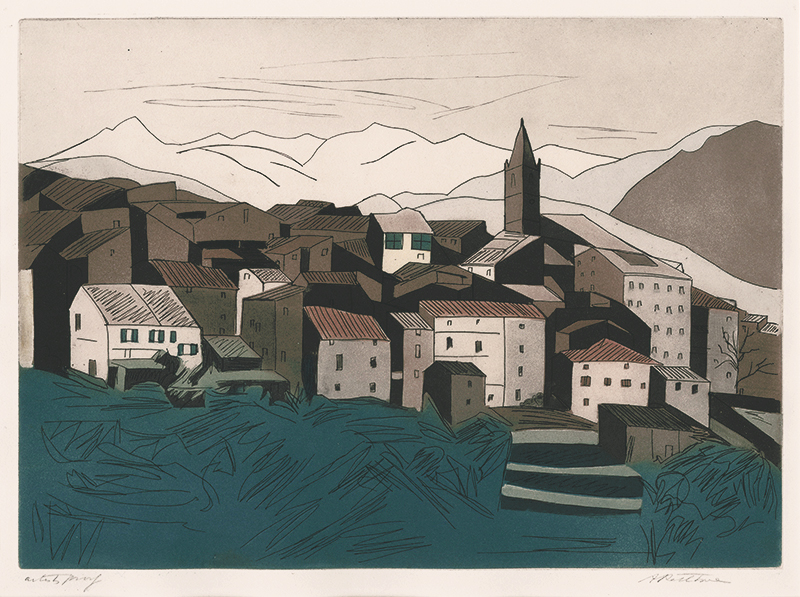Le Broc is an etching and color aquatint created about 1935 by American artist, Augusta Rathbone (1897-1990). It is pencil signed and inscribed artists proof and is from an edition of fewer than 15 impressions. Le Broc was printed in Paris by Monsieur Porcabeuf on ivory wove paper and the platemark measures 10-5/8 x 14-1/2 inches. Le Broc was reproduced in a smaller format then colored with pochoir for inclusion in the 1938 book French Riviera Villages.
The medieval village of Le Broc is located in the Alpes-Maritimes department in southeastern France, about four miles from Nice. The municipality is perched on a rocky outcrop that overlooks the rivers Var and Esteron, as well as Broc lake (Lac du Broc). Seen in the right half of the composition is the steeple of Ste-Marie-Madeleine, an early 16th century church. The quaint fishing village is home to around 1,500 residents now; however, when Augusta Rathbone created vibrant etching and color aquatint, the population was only around 300. In her image, she captured the contrast of pale stone facades against the jumble of dark angular roofs.
Rathbone produced twenty color aquatints of the French Riviera. In 1938 she joined forces with Juliet and Virginia Thompson to create the illustrated book, French Riviera Villages, published that year by Mitchell Kennerly. Twelve of Rathbone’s original color aquatints were reproduced, Juliet Thompson provided photography of the villages, and Virginia Thompson wrote a history on each village. The women joined forces to distribute their book after Kennerly failed to do so.
In 1921, upon graduating from the University of California at Berkeley, Augusta Rathbone continued her studies at the Académie de la Grande Chaumière in Paris. She also studied with Lucien Simon and, for seven years, with the Spanish artist Claudio Castelucho y Diana. In 1927, at the suggestion of Nora Hamilton of Chicago, Rathbone began to concentrate on printmaking and took her plates to Monsieur Porcabeuf for printing. Her earliest intaglios featured the Sierra Nevada and urban scenes of New York and San Francisco. After World War II, Rathbone returned to Paris but in the face of prohibitive printing costs she taught herself how to print her plates.
Rathbone exhibited at the Salon de Nationale, Paris, in the spring of 1930 and 1931 and in the autumn salon of 1937. Her work was included in the exhibition American Color Prints at the Brooklyn Museum in 1933, and a solo exhibition of her work was mounted at the San Francisco Museum of Art in 1940. She and Elizabeth Ginno showed together at the California State Library in Sacramento in 1952 and again, in 1954, at the de Young Museum in San Francisco. Rathbone's artistic affiliations included memberships in the California Society of Etchers, San Francisco Women Artists, American Artists Professional League, and the National Arts Club.
Augusta Rathbone's work is represented in the collections of the Brooklyn Museum, Brooklyn, New York; the Bowdoin College Museum of Art, Brunswick, Maine; the Zimmerli Art Museum, Rutgers University, New Brunswick; the Whitney Museum of American Art, New York; the Fine Arts Museums of San Francisco; and the Worcester Art Museum, Massachusetts.



